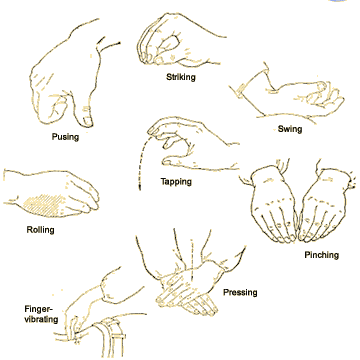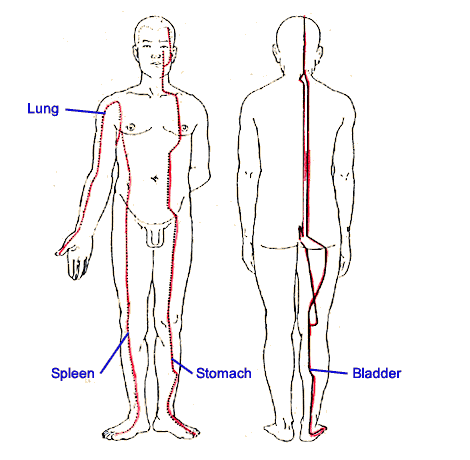VII. Massage for Weight Loss
TCM massage also called tu-na has been applied for 2000 years; it is widely used in Chinese medicine. The techniques are simple and fairly easy to manipulate and is especially good for localized slimming. It can be used on its own, but it is usually used in conjunction with other treatment strategies.
TCM massage therapy promotes qi (vital energy) and blood flow, helps to remove obstructions in the meridians and relieves stagnation. Different forms of pressure are applied depending on whether the aim is to tonify, to reduce, or to achieve a relative neutral, calming effect. Massage helps restore localized blood circulation and increases the metabolic rate and lipid break down in the targeted area.

Different forms of massage manipulations.
| 1. |
Topical massage
These are very simple and straightforward massage techniques. Choose the appropriate regions, e.g. abdomen, hip, waist and thigh, use a hot towel to rub and scrub the area first, and then apply the recommended amount of herbal paste on it. The strength of pressure depends on the thickness of fat tissues and individual's condition. Basically a person should feel comfortable after massage. The usual manipulations are pressing, rubbing, pushing and grasping techniques. Each session should last for 10-15 minutes and be performed two to three times daily. |
| |
|
| 2. |
Massage of acu-points
This massage technique concentrates on applying pressure to specific acu-points in order to achieve specific systemic changes in the body. The choice of acu-points is based on the type of diagnostic pattern that is used in acupuncture treatment. It is suitable for localized slimming.
For example, the protocol for the abdominal region is: Lying flat on the back, untie the belt and relax the whole body. Apply pressure on acu-points such as zhong-wan, zhong-shu and guan-yuen by pinching, rubbing, vibrating and pressing with palm manipulation. Sometimes digital-striking on the acu-points is used in order to reinforce the stimulations. Each session should last for ten minutes and be performed once daily. |
| |
|
| 3. |
Massage follows the meridians
Physicians massage areas through which the meridians run, and especially treat the acu-points along them. The meridians mainly focused on are the spleen, stomach, lung and bladder. Physicians usually manipulate them by using pushing, grasping, pressing, striking, pinching, rubbing and rolling techniques.

Massage can concentrate on specific meridians such as the speen, stomach, lung and bladder meridians.
For example, individuals lying flat on their back are massaged along the lung, spleen and kidney meridians; the usual selected acu-points are: zhong-fu, yun-men, ti-wei, sheng-wei, fu-jie, fu-she, zhong-wan, qi-hai and guan-yuan. Individuals lying face down are massaged along the bladder meridian; the usual selected acu-points are pi-shu, wei-shu and shen-shu. Massage should occur three times weekly; four weeks is considered one course. |
Although massage is generally very safe, some precautions should be noted. Never use massage on someone who is suffering from severe cardiovascular or liver disease; avoid massage on areas where there are lumps, tumors or skin lesions. Take extreme care with massage during pregnancy or menstruation and in elderly persons. A professional massagist should be sought where possible.
References
| 1. |
Flaws, Bob (2002). "New Approaches to the Chinese Medical Treatment of Obesity." In www.acupuncturetoday.com/archives2002/oct/10flaws.html. |
| 2. |
Kelley, Robert (2002). "Obesity and Weight Loss." www.herbldoc.com/weight.htm. |
| 3. |
Lu, Henry C. (1986). Chinese System of Food Cures, Prevention and Remedies. New York: Sterling Publishing Company, pp.161-75. |
| 4. |
Ren, Lingjuan, ed. (1999). Chinese Functional Food Edited. Beijing: New World Press. |
| 5. |
Zhang Enqin (chief ed.), Chinese Medicated Diet, Publishing House of Shanghai College of TCM, 1990. |
| 6. |
Ren, Zhuoren (2003). "Excess Weight and Obesity - A View from Traditional Chinese Medicine." www.edgenews.com/issues/2002/03/ren.html. |
| 7. |
Hu Shiu-ying (ed.), An Enumeration of Chinese Materia medica, The Chinese University Press, 1999. |
| 8. |
Li en (chief ed.), Integrated Clinical Encyclopedia of Traditional and Western Medicine, (Vol. 1), Chinese Medicine Classic Books Publishing House, 1999-9.
李恩主編, 中國中西醫結合臨床全書 (上冊), 中醫古籍出版社, 1999-9. |
| 9. |
焦東海編著, 實用肥胖病防治手冊, 東方出版中心, 2002-5. |
| 10. |
焦東海著, 焦東海科學減肥法, 上海遠東出版社, 2001-4. |
| Written By: |
| Jennifer Eagleton, BA & MA (Asian Studies), Integrated Chinese Medicine Holdings Ltd. |
| |
| Editors: |
| Angela Collingwood MSN, Integrated Chinese Medicine Holdings Ltd. |
| Jennifer Eagleton, BA & MA (Asian Studies), Integrated Chinese Medicine Holdings Ltd. |
| Lawrence Lau, Ph.D., Integrated Chinese Medicine Holdings Ltd. |
| Rose Tse, Integrated Chinese Medicine Holdings Ltd. |
Special thanks to Elpidio Talens Juan for helping with article graphics. |